#Dr. Samuel Mudd
Text





Last of the assassin month stuff, conspirator themed because I just finished Manhunt
#wont be doing the last day cause i dont feel like it#will probs draw more assassins one day soon#feel free to make insane requests to me though#rays art#assassination month#us history#john surratt jr#mary surratt#samuel arnold#michael olaughlen#dr samuel mudd
20 notes
·
View notes
Text


Draft letter to Dr. Richard Mudd from Jimmy Carter
Collection JC-COUNSL: Records of the White House Office of Counsel to the PresidentSeries: Robert J. Lipshutz's FilesFile Unit: Mudd, Dr. Samuel (deceased) 5/78-9/79
February 22, 1979 [Draft] Dr. Richard Mudd 1001 Hoyt Avenue Saginaw, Michigan 48607 Dear Dr. Mudd: I have for some time been aware of your efforts to clear the name of your grandfather, Dr. Samuel Alexander Mudd, the physician who set the broken leg of Lincoln assassin John Wilkes Boot [spelling error], and who was subsequently convicted as an assassination conspirator. Your tireless efforts for more than half a century to unearth and publicize the facts in the case and the questionable circumstances surrounding Dr. Mudd's conviction are commendable. Such persistence and faith are a tribute to the strength of familial love and dedication and are a credit to the great principles upon which our Nation was founded. That Dr. Mudd's conviction is questionable was clearly demonstrated by President Andrew Johnson who, on February 8, 1869, issued a full and unconditional pardon of Dr. Mudd. As President Johnson stated in issuing the pardon; "the circumstances of the surgical aid to the escaping assassin and the imputed concealment of his flight are deserving of a lenient construction, as within the obligations of professional duty, and, thus, inadequate evidence of a guilty sympathy with the crime or criminal." Furthermore, President Johnson concluded: "in other respects the evidence...leaves room for uncertainty as to the true measure and nature of the complicity." I have reviewed your petition and the petitions on behalf of your grandfather submitted to me by various members of Congress, several state legislatures, historians and private citizens asking that I, President, vacate the conviction of Dr. Samuel Mudd. I have requested and reviewed investigations by both the Department of Justice and the Office of the White House Legal Counsel to determine the authority of Dr. Richard Mudd February 22, 1979 Page Two the President of the United States to act in a case in which a civilian was convicted by a military commission of a crime against the Commander-in-Chief. After reviewing all issues and legal precedents relating to this case, I must conclude, regrettably, that it is not within the power of the President to make such a declaration. However, the case of Dr. Samuel Mudd is unique. In no other instance has so much been written, have so many voices been raised and have so many individuals endeavored to establish the innocence of Dr. Mudd and to seek his exoneration. In light of the evidence which has been amassed in the 113 years since his conviction, the injustice to Dr. Mudd and his family is clear. The phrase "your name is mud" has too long been used unjustly as an expression of contempt and scorn. The name of Mudd should be able to be borne proudly by all those who are descended from him. It is because of your unceasing efforts to clear your grandfather, and to restore to his name the dignity it deserves and that should be enjoyed by you and all the Mudd descendants, that I am writing to you to express my personal belief in the innocence of Dr. Samuel Alexander Mudd. For the sake of setting history straight, the name of Mudd should be cleared, once and for all, of any negative connotation or implied lack of honor. Sincerely, Jimmy Carter
19 notes
·
View notes
Text
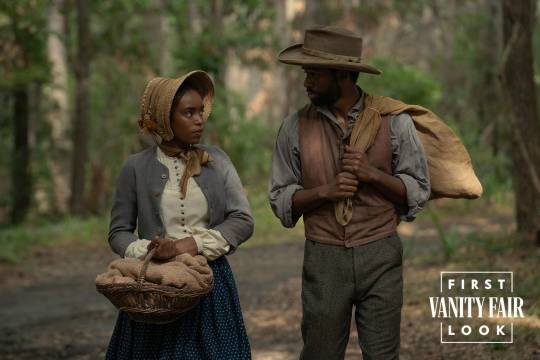
First Look: Lovie Simone as Mary Simms and Antonio Bell as her brother, Milo, who grapple with their orders to provide aid and comfort to President Lincoln's fugitive assassin in Manhunt (2024) on Apple TV+.
Mary Simms was enslaved by Samuel Mudd and later testified in the investigation into Lincoln’s killing.
“Mary Simms is someone that I came across in the transcript of the conspirators trial,” says producer and showrunner Monica Beletsky. “I found her extremely compelling. I knew that she kept house for Dr. Mudd and that her brother was considered Dr. Mudd’s carpenter. So with that in mind, when Booth needs a crutch, I have Milo, her brother, making the crutch.”
Manhunt is an adaptation of James L. Swanson’s novel about the pursuit of John Wilkes Booth.
(Source)
#Manhunt#Manhunt Series#Lovie Simone#Mary Simms#Antonio Bell#Milo Simms#period series#Monica Beletsky
31 notes
·
View notes
Text
Ghostly Whispers in the Dry Tortugas Fort Jefferson
The old prison, Fort Jefferson in the Dry Tortugas National Park is thought to be haunted by someone who was imprisoned there. Most fingers point to Dr. Samuel Mudd, imprisoned as a co-conspirator of the assassination of Abraham Lincoln.
The old prison, Fort Jefferson in the Dry Tortugas National Park is thought to be haunted by someone who was imprisoned there. Most fingers point to Dr. Samuel Mudd, imprisoned as a co-conspirator of the assassination of Abraham Lincoln.
In the turquoise expanse of the Gulf of Mexico, where the sun-drenched waters meet the vast sky, lies a cluster of islands known as the Dry Tortugas named…
3 notes
·
View notes
Text
The Trial of Major Wirz - Today In Southern History
23 July 1865
On this date in 1865…
The war crimes trial of Confederate Major, Swiss citizen, andAndersonville prison commandant Henry Wirz began in a show trial similar to that given Mary Surratt, Dr. Samuel Mudd, and others at the end of the War of Northern Aggression. He was charged with 13 murders. One of those he supposedly committed was said to have occurred in February of 1864, before…
0 notes
Text
The Secret Life of John Wilkes Booth
The date was April 14, 1865. The War Between the States was nearly at an end, with Robert E. Lee having formally surrendered to Ulysses S. Grant just five days earlier. President Abraham Lincoln, who was in good spirits, celebrated the excellent news by accepting an invitation to a play.
Of course, anyone who's made it through fifth-grade social studies knows what happened next. John Wilkes Booth, actor and Confederate sympathizer, made his way into Lincoln's theater box and shot the president in the back of the head with a single-shot Deringer pistol.
Booth had counted on a quick getaway, but had trouble when he leaped from the box and clumsily caught his riding spur on a U.S. Treasury Guards flag, tumbling to the stage and breaking his leg. Nevertheless, after shouting that infamous cry, "Sic semper tyrannis!-the Virginia state motto meaning "Thus always to tyrants"-Booth ran outside, mounted the horse that was waiting for him, and rendezvoused with fellow conspirator David Herold in Maryland.
After staying that night with acquaintance Dr. Samuel Mudd, who reset Booth's broken leg, Booth and Herold fled for Virginia, where they were discovered several days later hiding out in a barn. Surrounded by Union soldiers in the early morning hours. Herold surrendered, but Booth stood his ground. As the soldiers began setting fire to the barn, a sergeant named Boston Corbett spotted Booth through a gap in the wall and fire at him, striking him in the back of the neck. Booth succumbed to his wounds a few hours later and was eventually buried in the family plot in Baltimore, Maryland. (Cue the suspenseful music.) Or was he?
Thirty-eight years later, a man by the name of David E. George would raise doubt concerning the fate of Lincoln's assassin. In January 1903, in a long narrow room on an upstairs floor of the Grand Venue Hotel in Enid, Oklahoma, Georgia made a settling confession. He was dying, and although a doctor had been called to his bedside, there was nothing the physician could do; George had ingested a fatal dose of strychnine. As the dying man drew his last breath, he confessed that David George was just an alias. His real name was John Wilkes Booth, and he had killed Abraham Lincoln.
None of the locals really seemed to know that much about George. He was a self-professed house painter and devoted barfly, that much they could say-though he was fond of quoting Shakespeare, which he did at length when he was on the drink, which raised speculation that he may have once been very familiar with the stage. Was it possible that he was who he claimed to be?
The evidence began to pile up. Upon examination of George's body, doctors noticed scars that matched those Booth would have had. He had also suffered a broken leg sometime in the past, just above the ankle, as Booth had when he leaped to the stage at Ford's Theatre. Plus, he shared Booth's height and features, and was the proper age. Moreover, a minister by the name of E. D. Harper revealed that, during a previous suicide attempt, George had confessed once before to being Booth.
Still, nothing came of the matter. And since no one came forward to claim the body, the local mortician mummified George, dressed him up and set him on display in the front window of his funeral parlor/furniture store. Despite George's supposedly astonishing revelation, he remained little more than a minor curiosity.
The mystery grew, however, when Finis L. Bates, a lawyer from Memphis, heard about George's claim, traveled to Enid to see the corpse for himself and identified it as the man he once knew as John St. Helen. St. Helen, he said, had been a friend of his back when he worked in Granbury, Texas, in the 1870s. Furthermore, at a time when St. Helen was gravely ill and believed he was lying on his deathbed, he confessed to Bates that he was the man who killed Lincoln and proceeded to described the whole affair in detail. St. Helen recovered, however, and left town, supposedly for Oklahoma. Bates who spent years investigating the claim, tried to bring the incident to the attention of the U.S. War Department, but he was dismissed.
Since then, more than a handful of theorists have concluded that it's plausible, if not entirely likely, that John Wilkes Booth actually escaped following the assassination of America's sixteenth president. Many believe Booth was involved in a conspiracy with the U.S. government to have Lincoln killed and was allowed, even helped, by the military to make his getaway. The man who was killed that night in the Virginia barn was either a patsy or someone shot by mistake. Oddly enough, there have been some clues, although yet unsubstantiated, that Boston Corbett, the man credited as Booth's killer, also lived out his final days in Enid, which raises some interesting questions about a possible association between him and David George. In recent years, a group of researchers, joined by several members of the surviving Booth family, petitioned to disinter the man buried in John Wilkes Booth's unmarked plot in Maryland to prove whether or not he's really the man he's supposed to be. Unfortunately, their request was denied. So, the mystery, at least to many, is still unsolved.
As for David George's mummy, Finis Bates acquired it from the funeral parlor in Enid and toured the country with it, putting it on display and renting it out to carnivals. It even made an appearance at the 1904 St. Louis World's Fair. Following Bates's death, the mummy changed hands several times and was eventually lost.
The hotel in which David George made his confession, however, still stands in Enid at 205 S. Grand Avenue. Today it's the site of Garfield Furniture.
0 notes
Text
Episode 354 - Zachary Scott
His star in Hollywood didn't burn bright for long, but Zachary Scott made memorable impressions as mysterious villains in movies like Mildred Pierce. In his one and only appearance on Suspense, Scott plays a man accused of bumping off an annoying neighbor in "Murder Off Key" (originally aired on CBS on November 15, 1945). Plus, he stars as the infamous Dr. Samuel Mudd - the man who treated John Wilkes Booth when the assassin was on the lam and later stood trial as a co-conspirator - in "The Prisoner of Shark Island" from Encore Theatre (originally aired on CBS on August 13, 1946).
Check out this episode!
0 notes
Text
https://lincolnconspirators.com › tre...
Treasures of the Dr. Samuel A. Mudd House Museum
This kid is made with shark colors on the outside calculator not the same cane and the word won't come out it is shark cartilage and this one that they have in the roadshow is not and it is mine and it was used to present things in the medical community that were new and you would walk in with it and you would point at things and the reason was the doctor might was a famous famous doctor who came up with many curious and it was Dave and Dave I was conspiring supposedly with BG you can see Jose Gaspar when the painting that they had of the women that were naked last night doing the painting they didn't know it and they're in Provincetown somewhere and it was quite a while ago during colonial time some at some point and they're talking about what they saw with the women bathing very clean and very white and the water is not miscolored that's very clear so it's probably venom and Dave wants to know if he knows and he's a curious boy so he got in trouble that happened a lot with Dave
Mac daddy
0 notes
Text
Assistir Filme The Prisoner of Shark Island Online fácil
Assistir Filme The Prisoner of Shark Island Online Fácil é só aqui: https://filmesonlinefacil.com/filme/the-prisoner-of-shark-island/
The Prisoner of Shark Island - Filmes Online Fácil

Depois de definir a perna de John Wilkes Booth, o Dr. Samuel Mudd é enviado para a prisão como conspirador no assassinato de Abraham Lincoln.
0 notes
Photo



"Letter from D. W. Whitehurst, MD to Major G. P. Andrews in regards to the conduct of Dr. Samuel Mudd during the yellow fever outbreak at Fort Jefferson," 2/24/1868
File Unit: B-596, Samuel A. Mudd, 1865 - 1931. Series: Pardon Case Files, 1853 - 1946. Record Group 204: Records of the Office of the Pardon Attorney, 1846 - 1989.
#Dr. Samuel Mudd#Dr. Mudd#yellow fever#Fort Jefferson#D.W. Whitehurst#Major G.P. Andrews#civil war#civil war history#Lincoln assassination#February 24#1868#1860s#1800s#archivesgov
30 notes
·
View notes
Text
Treasures abound at Florida’s Dry Tortugas National Park
Treasures abound at Florida’s Dry Tortugas National Park
The seaplane kissed the water as we landed at Dry Tortugas National Park, one of our country’s most inaccessible national parks. It had been a smooth flight from Key West, where we had departed a mere thirty-five minutes ago, and the sights en route were incredible.
Opting for the seaplane to Dry Tortugas was a no brainer for me, as the only other means of getting there is the ferry, which…
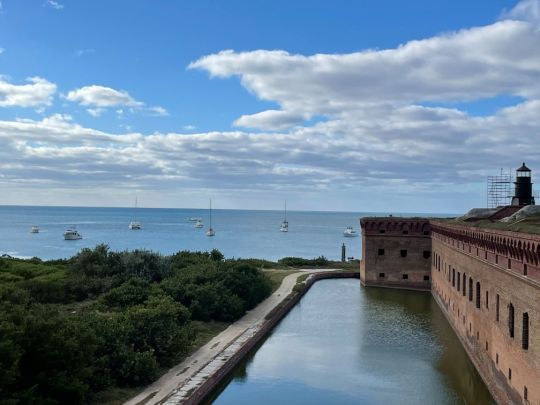
View On WordPress
#David Wolkowsky#Debbie Stone#Dr. Samuel Mudd#Dry Tortugas National Park#Fort Jefferson#Key West Charter Planes#Ponce De Leon#Put a pin in it!
0 notes
Text
The Other Lincoln Assassination Conspirators
The assassination of Abraham Lincoln was not intended to be an isolated murder of the president. It was carried out as part of a larger conspiracy to destabilize the United States government by murdering its top three officials: President Abraham Lincoln, Vice President Andrew Johnson, and Secretary of State William Seward. John Wilkes Booth, the leader of the conspiracy, succeeded in assassinating the president. The other intended assassinations failed. Nonetheless, eight conspirators were tried before a Military Commission beginning on May 10, 1865, for their roles in the assassination conspiracy. (A ninth, John Surratt, fled the country.) Who were the eight people who stood trial?
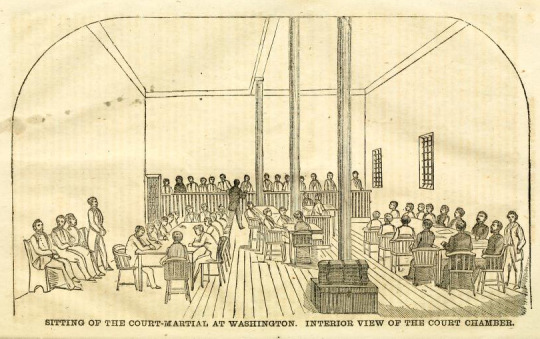
Six men were directly linked to John Wilkes Booth’s conspiracy and actions on the night of April 14th: Samuel Arnold, Edmund Spangler, Michael O'Laughlen, George Atzerodt, Lewis Powell [aka Payne], and David Herold.
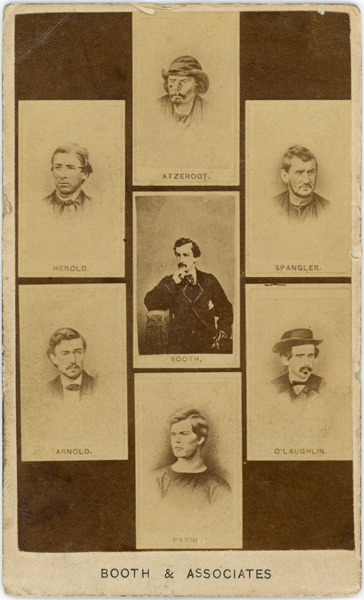
Samuel Arnold (1834-1906) had attended school with Booth. The two men remained friends, and Booth recruited Arnold to join a plot to kidnap Lincoln and take him to Richmond as a hostage to be exchanged for Confederate prisoners. Arnold enthusiastically supported the kidnap plan, but when that plan fell through, he left Washington and was not in the city on the night of April 14th. He had, however, written a letter to Booth in late March that stated, “None, no, not one were more in favor of the enterprise than myself.” Arnold’s lawyer argued that “the enterprise” Arnold supported was the proposed kidnapping not the assassination. The Military Commission did not agree and found Arnold guilty of conspiracy to assassinate the president. Arnold was sentenced to life in prison, but he was pardoned in 1869 by President Andrew Johnson. He died of tuberculosis in 1906.

Edmund Spangler (1825-1875) was employed as a scene shifter and carpenter at Ford’s Theatre, where he became acquainted with Booth and often tended the actor’s horse when Booth was in the theater. That is what Booth asked Spangler to do the night of April 14th. That night Spangler handed that duty over to Joseph Burroughs. But after Booth shot Lincoln and ran out the back door of the theater to his horse, Spangler was accused by others at the theater of not stopping the assassin as he ran out and telling people to say nothing about Booth’s escape. His lawyer argued that Spangler had not known Booth’s intentions, but the court found him guilty and sentenced him to six years in prison. He was pardoned by President Andrew Johnson in 1869 and spent the rest of his life in Maryland on five acres given to him by Dr. Samuel Mudd.

Michael O’Laughlen (1840-1867) was Booth’s Baltimore neighbor and childhood friend. He fought in the Confederate army briefly and then returned to Baltimore. In 1864 Booth recruited him for the kidnapping plot. Although it’s not clear what role he might have had in the conspiracy to kill Lincoln, he surrendered voluntarily to federal authorities on April 17th. At the trial, prosecution witnesses claimed that O’Laughlen had been seen before the assassination at Secretary of War Edwin Stanton’s house asking about the secretary’s whereabouts. His defense claimed he has spent the night of the 14th wandering Washington and drinking. O’Laughlen was found guilty of conspiracy and sentenced to life in prison at Fort Jefferson in the Dry Tortugas, Florida, where he died during a yellow fever epidemic in 1867.
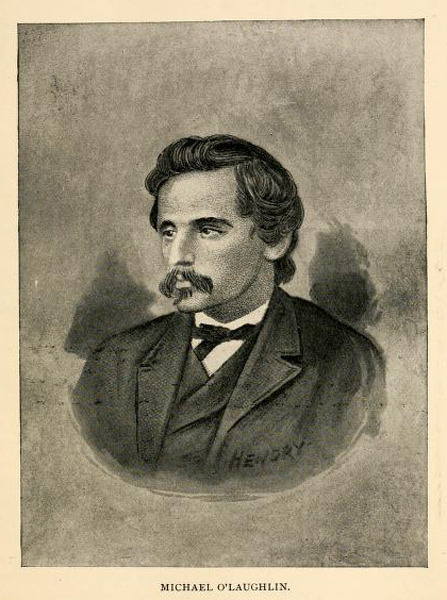
George Atzerodt (1843-1865) had actively supported the Confederacy during the war by ferrying Confederate spies across the Potomac. He was a carriage repairman by trade and had been recruited by Booth to join the kidnapping plot. When the plot turned to assassination, Booth assigned Atzerodt the job of assassinating Vice President Johnson. On April 14th the would-be assassin checked in to Johnson’s hotel where he stashed a revolver and bowie knife in his room. He then proceeded to the hotel bar where he asked a bartender about Johnson’s whereabouts and began drinking to build up his courage. He never looked for Johnson but visited at least one other hotel bar, got drunk, and spent the night wandering around Washington. A search of Atzerodt’s room on April 15th made him a prime conspiracy suspect. He was arrested on April 20th. Although his lawyer called witnesses who confirmed that Atzerodt was a “notorious coward” unable to assassinate anyone, Atzerodt was found guilty of conspiracy and sentenced to death. He was hanged on July 7, 1865.

Lewis Powell (1844-1865), also known as Lewis Payne, joined the Confederate army at age 17, was wounded at Gettysburg, captured, and transferred to a hospital in Baltimore. He escaped from the hospital, joined the Confederate Mosby’s Rangers, and became involved with the Confederate Secret Service. By January 1865, Powell had returned to Baltimore, claiming to be a deserter, and taken the Oath of Allegiance to the Union under the name Lewis Payne. He was introduced to Booth by John Surratt, and Booth recruited him to provide the muscle for the original plot to kidnap Lincoln. Booth then assigned Powell to kill Secretary of State William Seward. Powell very nearly succeeded, forcing his way into Seward’s house and severely injuring Seward’s son, his bodyguard, and Seward himself. He then escaped but was arrested two days later at Mary Surratt’s boardinghouse. At his trial, Powell’s lawyer argued that he was a delusional and misguided “fanatic” whose life should be spared. It was not—Powell was found guilty and hanged on July 7, 1865.

David Herold (1842-1865), a pharmacy clerk in Washington, D.C., had been a schoolmate of John Surratt, who introduced him to Booth in 1864. Booth recruited him for the kidnapping plot, and he remained a conspirator when the plot turned to assassination. On the night of April 14th, Herold went with Lewis Powell to Secretary Seward’s house. While Powell was inside attacking Seward, Herold was supposed to stand outside and hold Powell’s horse. But he lost his nerve and abandoned Powell, leaving the horse tied to a tree. He made his way to Maryland where he met up with Booth. The two men went first to Surrattville to retrieve weapons hidden there and then on to the home of Dr. Samuel Mudd, who set Booth’s broken leg. Herold and Booth remained on the run until April 26th when Union cavalry trapped them in a barn on Richard Henry Garrett’s farm. Herold surrendered when soldiers set the barn on fire. Since Herold had declared “We are the assassinators of the President” as he passed the guard on the bridge to Maryland, there was little doubt about the outcome of his trial. His lawyer attempted to portray Harold as simple—possibly simple-minded—“boyish” and easily influenced by the sophisticated Booth who “exercised unlimited control over this miserable boy, body and soul.” The argument failed to save Herold from a guilty verdict and death sentence. He was hanged on July 7, 1865.
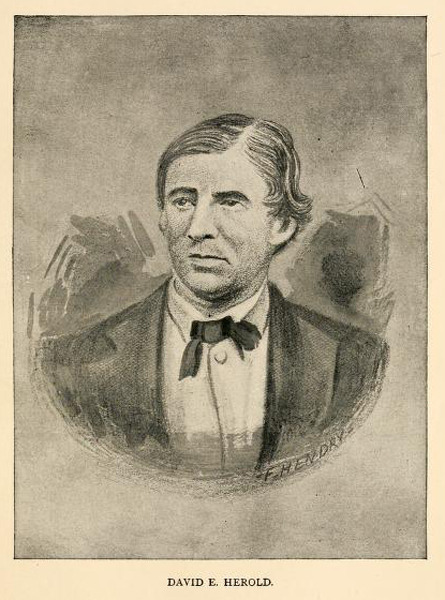
In addition to the six men recruited by Booth, Dr. Samuel Mudd and Mary Surratt were accused of aiding the conspirators. Their roles in the assassination conspiracy were controversial at the time and have remained so ever since.

Dr. Samuel Mudd (1833-1883) practiced medicine on his farm outside Bryantown, Maryland. He supported the Confederacy and was open about his dislike of the Lincoln administration. Early on the morning of April 15th, Booth and Herold arrived at Mudd’s farm, and the doctor set Booth’s broken leg. He then had crutches made for Booth and directed the two fugitives to their next destination. When soldiers arrived in pursuit of Booth, Mudd claimed he had not known the man whose leg he had set and did not recognize photographs of Booth. At his trial, a number of witnesses testified that Mudd knew and associated with both John Surratt and Booth before the assassination. The prosecution argued that the doctor had aided the conspiracy by treating the injured Booth and directing him further along his escape route. Mudd was convicted and sentenced to life in prison at Fort Jefferson in the Dry Tortugas, Florida. Mudd’s actions treating inmates and staff at the prison during the 1867 yellow fever epidemic helped earn him a pardon from President Andrew Johnson in 1867. After his release, Mudd returned to Maryland where he died of pneumonia in 1883.
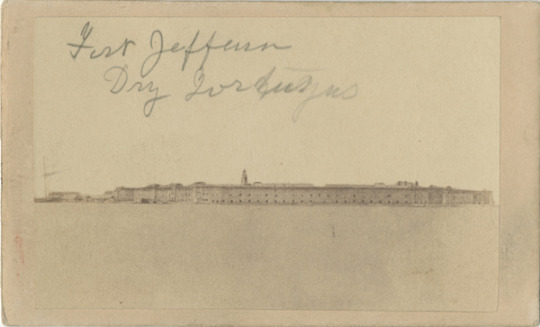
Mary Surratt (1823-1865) owned a boardinghouse in Washington where Booth visited quite often and the conspirators met. Her son, John Surratt, was a Confederate agent and a conspirator. She also owned a tavern in Surrattsville, where she had told her tenant to hide weapons for later pick up and where she met and talked with Booth on April 14th. Booth also appeared at her Washington boardinghouse early on the evening of April 14th, and he and Herold retrieved the hidden weapons from her tavern later that night as they made their escape. Powell appeared at the boardinghouse late on the night of April 17th while federal investigators were interviewing her. Mary Surratt was arrested following that interview. At her trial she was found guilty and sentenced to death. Five of the nine Commissioners who heard her case recommended that President Andrew Johnson reduce her sentence to life in prison, but Johnson refused. Mary Surratt was hanged on July 7, 1865—the first woman executed by the United States government.
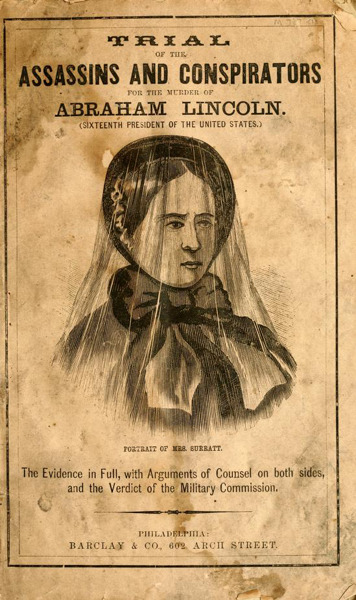
#Lincoln Assassination#Lincoln Conspirators#Samuel Arnold#Edmund Spangler#Michael O’Laughlen#George Atzerodt#lewis powell#David Herold#Dr. Samuel Mudd#Mary Surratt
5 notes
·
View notes
Photo

Happy National Mudd Day!
0 notes
Note
If the Lincoln assassination had happened in the 1900s or 2000s do you think there would have been conspiracy theories about it like the JFK assassination?
Abraham Lincoln's assassination really WAS part of a conspiracy. I feel that people sometimes forget what "conspiracy" or "conspiracy theory" actually means and automatically think of some dark plot by the government when the actual definition is pretty straightforward:

John Wilkes Booth and his group of conspirators met at Mary Surratt's boarding house and initially considered kidnapping President Lincoln before deciding to kill him. The Booth conspiracy called for simultaneous attacks in Washington to decapitate the federal government: Booth was supposed to kill the President, George Atzerodt was supposed to kill Vice President Andrew Johnson, and Lewis Powell/Paine was supposed to kill Secretary of State William H. Seward. Another conspirator, David Herold, was meant to help Powell gain access to Seward's home and then lead the way for the conspirators during their escape from Washington.
While Booth succeeded in shooting the President, the rest of the conspiracy quickly fell apart. Atzerodt lost his nerve and got drunk, so he didn't even attempt to kill Vice President Johnson. Powell did gain admittance to Seward's home and very nearly killed the Secretary of State, but Seward somehow survived the vicious stabbing. Herold, who was waiting for Powell during the attack on Seward, also panicked and took off, leaving Powell to find his own way out of the nation's capital. Herold did hook up with Booth after Lincoln was shot at Ford's Theatre and helped Booth, who had broken his leg while jumping down from the Presidential box after shooting Lincoln, get out of Washington and escape into Virginia where the Confederate sympathizers expected to be safe and welcomed as heroes for killing Lincoln.
So, the events of the Lincoln assassination are pretty much the textbook definition of a conspiracy. And while Booth refused to surrender after being tracked down by Union soldiers and was eventually killed, Herold, Powell, and Atzerodt were all arrested, as was Mary Surratt (the woman whose boarding house was where the conspirators had met and planned the assassination) and Dr. Samuel Mudd, a doctor who set Booth's broken leg in the hours after the assassination. All of the surviving conspirators were put on trial and convicted. Herold, Powell, Atzerodt, and Mrs. Surratt were sentenced to death and executed by hanging. Dr. Mudd narrowly avoided the death penalty, but was sentenced to prison along with three other men who were convicted of being complicit in the conspiracy but not involved deeply enough to warrant the death penalty.
There were rumors of a bigger conspiracy in the days immediately after the assassination. The Civil War had ended just six days before Lincoln's death, so there were questions about whether or not the Confederate government had played a role in the assassination. Even after Booth was hunted down and killed, the federal government considered Confederate President Jefferson Davis a suspected conspirator and issued a $100,000 reward for Davis's capture, with a poster suggesting that the Confederate President "incited and concerted the assassination of Mr. Lincoln, and the attack upon Mr. Seward".
Davis was eventually captured, but there was no evidence that the Confederate President -- or any other high-ranking officials of the Confederate government played a role in Lincoln's assassination. Davis himself would later suggest that "Next to the destruction of the Confederacy, the death of Abraham Lincoln was the darkest day the South has ever known." Davis and the defeated Confederate leadership would have much rather preferred Lincoln's plans for Reconstruction than those of Andrew Johnson, who was the only Senator from one of the states that seceded from the Union to join the Confederacy who refused to join the rebellion and held on to his seat. As Davis would later write, "For an enemy so relentless in the war for our subjugation, we could not be expected to mourn; yet, in view of its political consequences, it could not be regarded otherwise than as a great misfortune to the South. [Lincoln] had power over the Northern people, and was without personal malignity toward the people of the South; his successor [Andrew Johnson] was without power in the North, and the embodiment of malignity toward the Southern people, perhaps the more so because he had betrayed and deserted them in the hour of their need."
The only direct ties between the Confederate government and John Wilkes Booth's conspiracy seemed to be those of Mary Surratt's son, John, who was friends with Booth and introduced the actor to several of the conspirators. John Surratt was a Confederate spy, so he was suspected of involvement despite being out of state and in the north on the day of Lincoln's murder. When he was eventually put on trial for his involvement, Surratt admitted that he had been part of the earlier plan to kidnap Lincoln but did not join the plot to kill the President. Surratt was never convicted of being involved in the assassination.
#Conspiracy#Conspiracies#Conspiracy Theory#Lincoln Assassination#Abraham Lincoln#Assassination of Abraham Lincoln#John Wilkes Booth#Booth Conspiracy#Lincoln Conspiracy#History
49 notes
·
View notes
Text
Lincoln Assassination
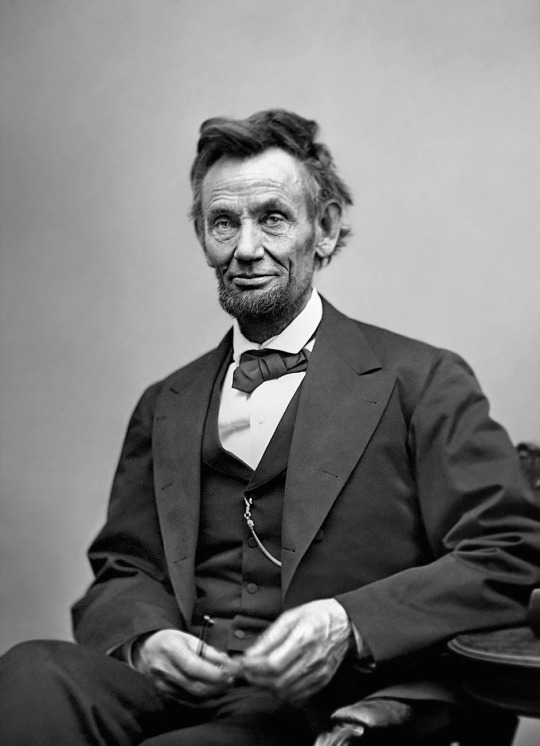
On April 9th 1865, after General Robert Lee surrendered to General Ulysses S Grant in Appotamox Virginia.
On 11th April 1865, Abraham Lincoln who was the 16th President of the United States, delivered his last ever speech.
"We meet this evening, not in sorrow, but in gladness of heart. The evacuation of Petersburg and Richmond and the surrender of the principal insurgent army give hope of a righteous and speedy peace whose joyous expression can not be restrained."
Abraham Lincoln visited Ford's theatre in Washington D.C, after deciding to take the evening off, with his wife and two friends, Clara Harris and Henry Rathbone. They arrived at 8:30pm on April 14th. However, for the last three months, unbeknownst to Lincoln or any authorities John Wilkes Booth, an actor and his co-conspirators came up with a plan to the Confederate prisoners of war.
Booth's plan along with his co-conspirators was to kidnap the president and hold him hostage until he released the prisoners, however due to the war coming to an end on 9th April their plan had to change.
Now, John Wilkes Booth along with fellow co-conspirators Mary Surrat, George Atzerodt, William Seward and David Herold decided they had to murder not only the president but members of his cabinet too.
John Wilkes Booth regularly visited Ford's Theatre and happened to know the place like the back of his hand so after finding out information earlier on the morning of April 14th that President Lincoln would be visiting the theatre later that evening the plan was set in place. Booth would head to the State Box (the presidential seating) and end Lincoln's life. Lewis Payne was tasked with killing the secretary of State, William Seward along with David Herold, it was George Azterodt's job to end Vice President Andrew Johnson's life whilst The murders were to take place at 10:15pm. Lincoln arrived at the theatre to watch a performance of Our American Cousin at approximately 8:30pm with Booth arriving outside an hour later.
Once John Wilkes Booth arrived at the rear alley on his horse, he spoke to a young boy who worked there named William Burroughs asking him to mind his horse. There was a saloon situated next to Ford's theatre and Booth needing some liquid courage for the task at hand decided to stop for a drink before heading to the theatre. He finally entered the theatre to assassinate the President at 10:07pm.
Luckily for Booth once he reached the State Box he found that Presiden Lincoln was unprotected due to his Metropolitan Police Force bodyguard, Mr John Palmer, temporarily leaving his post. Armed with a single shot Derringer and a hunting knife, Booth shot Lincoln point blank in the back of the head before stabbing his friend Henry Rathbone and jumping 11 feet, in front of 1000+ people, to the stage below. Whilst Lincoln's wife screamed Booth yelled "Thus always to tyrants" and flashed his knife.
Despite jumping 11 feet Booth was left with a broken fibula just above his ankle. President Lincoln sadly was not so lucky after the bullet entered through Lincoln's left ear, lodging behind his right eye. He was left paralyzed and struggling to breathe. He didn't regain consciousness and unfortunately died nine hours later at the Petersen House across from Ford's theatre.
After the assassination and breaking his fibula John Wilkes Booth managed to limp away, hop on his horse and gallop away. He rode his horse until he reached Surratsville so he could be joined by David E Herold at Dr Samuel Mudd's house where the Dr set Booth's leg and helped by splintering it. They stayed the night before leaving, headed south, on the afternoon of April 15th.
It only took eleven days for the Feds to catch up to Booth and Herold. When confronted Booth chose to end his own life whereas Herold surrendered.
After all the chaos and misery that they had caused, Mary Surrat, Lewis Paine, George Atzerodt and David Herold were publicly hanged at the Old Penitentiary Gallows on 7th of July 1865. Lincoln's death shook the nation and despite nobody else losing their life from their plan, Atzerodt never made any attempt on Vice President Johnson's life. Lewis Paine had been successful in harming the Secretary of State William Seward's throat after slashing it - twice!! - he only failed his mission due to Seward having a surgically inserted iron collar.
Business soon had to go back to normal as Vice President Johnson took his place as 17th President of the U.S.A.
#true crime community#tcc#true crime#murder#assassinations#lincolnassassination#follow#reblog#popular#true crime facts#tumblr#crime#crime facts#facts about crime#facts about true crime#interesting#usa#president#president lincoln#abraham lincoln#full information#interested#new facts#facts#headshot#ford theatre#death#dying#assassin
5 notes
·
View notes